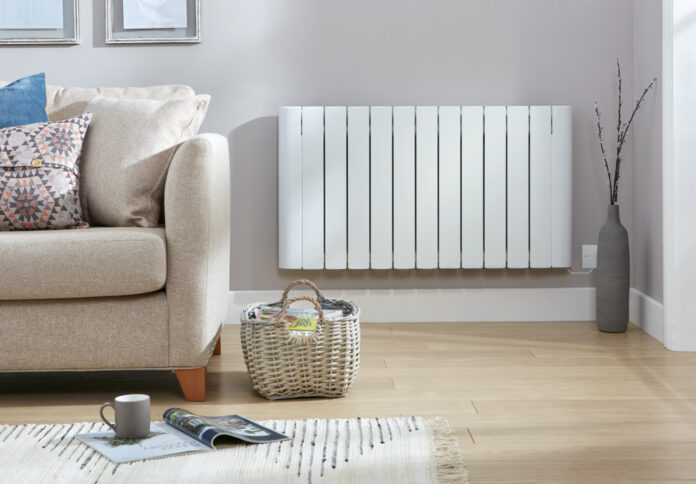Heating systems aren’t just great for your comfort and convenience. They’re also more efficient than other forms of home heating. Home radiant heating systems are available in many shapes, forms, and sizes. Some radiant heaters can be installed under floorboards to warm up the entire space of a room evenly. Others act as radiators that can be placed on the walls or above ceilings to create an even ambient temperature throughout the home.
Radiant heaters are also available as portable units that can easily move around your home when needed! If you need extra warmth while working on a project around the house or hosting a company for dinner, then simply set up your portable radiant heater in another room for added comfort!
Some Radiant Heaters Come With Remote Controls.
Some radiant heaters come with remote controls. This is an advantage because it allows you to control the unit from another room in your home or outside the house. For example, if you’re too busy to go into the room where your heater is installed and adjust its temperature settings, a remote control will make it much easier for you to do so.
Remote controls are also useful if several people live in your home who want their individual temperature preferences (or none). Suppose you have children who like warm things while they sleep, but their parents prefer cooler temperatures when awake during the day. This feature will allow everyone to adjust their thermostats without leaving their rooms or disturbing one another unnecessarily.
Some radiant heaters have built-in timers that let homeowners set up pre-programmed heating cycles throughout the day and night—this saves electricity costs by only turning on when necessary instead of running continuously for 24 hours every day!
 Low Radiant Heating System Cost Leads To Reduced Bills.
Low Radiant Heating System Cost Leads To Reduced Bills.
If you’re looking for a way to save money on your heating bill, consider using radiant heating. Radiant heating system cost is low and energy efficient and can reduce your heating bill by up to 50%. This is particularly true in winter when the outside temperature drops below freezing.
Radiant heaters rely on electric resistance wires that warm up as they pass current through them. The warmth generated by these wires is transferred directly into dry air, being pushed through them at high speeds, making it feel warmer than the actual air temperature. Radiant heaters still require ductwork (which may cost less than baseboards). Still, because no open flames or hot surfaces are involved, they’re safer overall than other forms of heat distribution.
Radiant Systems Offer A Means To Zone Different Parts Of Your House.
Radiant heating systems offer a means to zone different parts of your house. The system can heat different house parts at different temperatures or schedules.
This is a great advantage because it allows you to select the temperature for each room that is most comfortable for you and your family, rather than being forced to choose an overall solution that may not work for everyone in your home.
In addition, radiant heaters can be used in conjunction with traditional forced air HVAC systems (furnaces). This will reduce energy costs by providing supplemental heating throughout the house when needed and then switching back over to natural gas or propane furnace when it isn’t needed anymore.
Efficient Electric Radiant Heat Ceiling Panels
Radiant heating systems are also good for allergy sufferers since no dust or dirt is circulating through the air.
Electric radiant heat ceiling panels are more efficient than forced-air systems because they only heat your room. If you’ve ever had a forced-air heater go out while taking a shower, you know just how cold it can get when that happens!
Radiant heat is also more comfortable than forced air because of its even distribution throughout your home and its ability to warm floors and walls. You’ll feel warmer all over your body with radiant heating instead of being stuck with just one part of your body being heated by an old furnace!
Radiant Heating Systems Don’t Produce Dust Particles In The Air.
When it comes to air quality, radiant heaters win hands down. With forced-air systems, the combustion process produces dust particles that can cause allergies and asthma. In addition to the harmful effects of these particles on your health, they also reduce the efficiency of your HVAC system by blocking its filters or reducing its ability to operate at peak performance.
Radiant heaters don’t produce this airborne dust because there’s no combustion involved in their operation. These systems are designed with a sealed thermal mass that stores heat energy without releasing any particulate matter into your home’s atmosphere—which means you’ll get continuous comfort while maintaining healthy indoor air quality levels throughout every room in your home.
Radiant Heating Provides The Ideal Environment For Hardwood Floors.
While there are several benefits to a radiant heating system, one of the greatest is that it can provide the best environment for hardwood floors. Hardwood floors have been around for centuries, and they are still considered to be an attractive and durable flooring option.
Radiant heat is more energy efficient than forced air because it heats the floor, which heats the air. By heating the floor first, you won’t have issues with uneven heating or cold spots on your wood floors like you would if you used a forced-air system.
Infrared Floor Heating Heaters Can Be Installed Under Floorboards.
In the past, installing radiant heaters was not an option for many homeowners because they required holes to be drilled into the floorboards. Fortunately, this is no longer a concern. The infrared floor heating systems can be installed under floorboards, ceilings, and on walls and floors. If your home has windows with openable frames (i.e., casement windows), you can install radiant heaters there too! It’s important to note that every installation is unique and may require different materials; consult a professional if you have any questions about your project before beginning it yourself.
Home Radiant Heat Systems Are Super Quiet And Very Energy Efficient.
In addition to being wonderfully warm and cozy, radiant heating systems are also super quiet and energy efficient. Because they heat the air directly around you instead of warming the room from above like a forced air furnace, they don’t make as much noise. Also, because they don’t require any ducts (and therefore aren’t dependent on ductwork), they can be used in smaller rooms without sacrificing efficiency. This makes them ideal for apartments or townhomes where space is premium but comfort isn’t! For example, if your home doesn’t have enough space for ductwork needed by a traditional HVAC system, radiant floor heating may be a better option than forced air.
Conclusion
Radiant heating systems offer a variety of benefits and are an excellent option to consider when upgrading your home’s heating system. They provide efficient heat without the need for ducting or venting, which means less work for you as a homeowner. They also allow you to control your heating costs by adjusting the temperature on each floor separately so that you only use as much energy as needed at any given time. This can help save money in both the summer and winter months!
Related Websites
Articles on Blogshunt
Articles on Blogseu
Articles on Blogspeoples
Articles on Thebigblogtheory
Articles on Allcityforums

